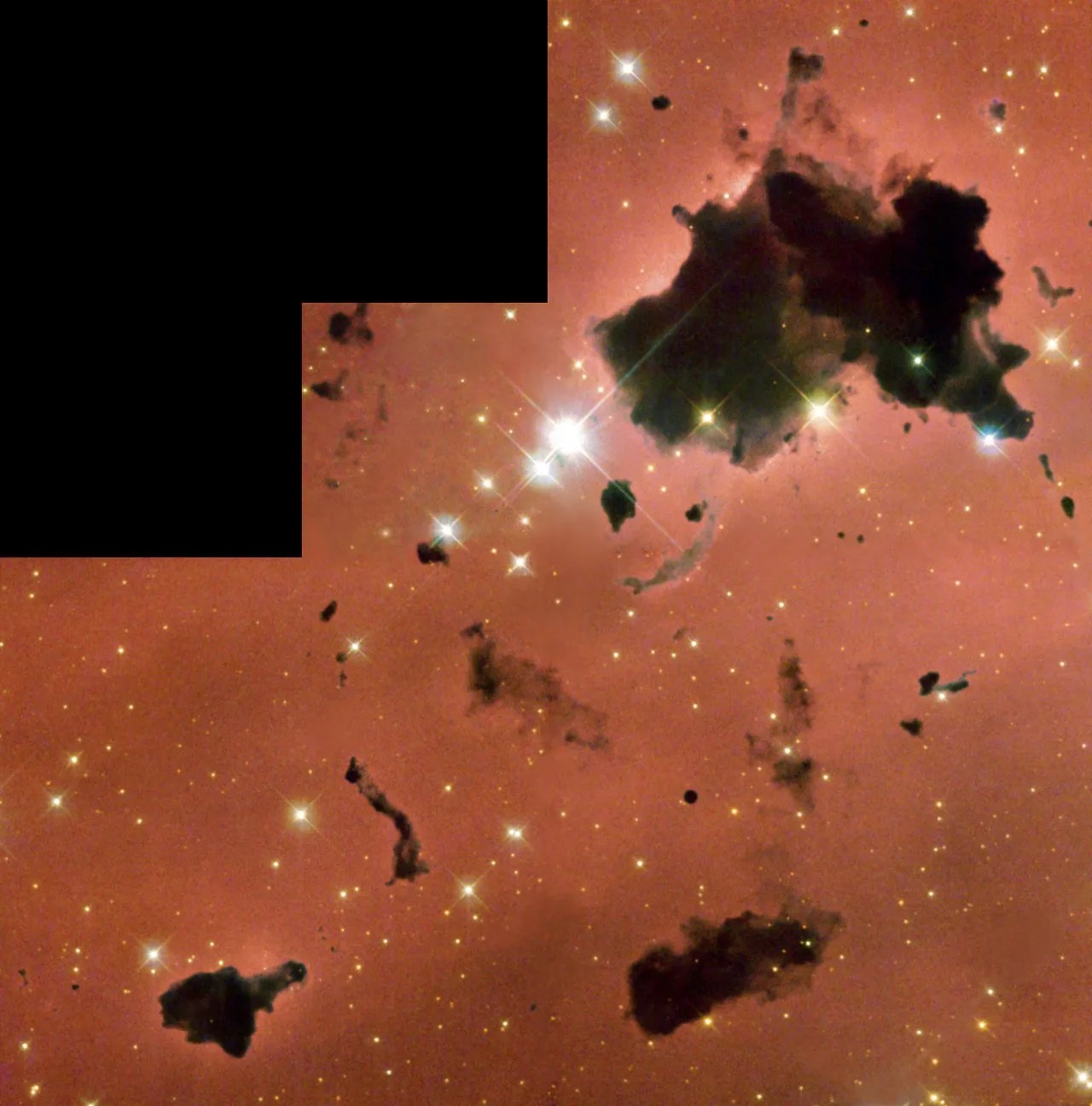Caldwell 100
With dark clouds, an emission nebula, and embedded star clusters, Caldwell 100 offers a wealth of things to see.
Distance
6,000 light-years
Apparent Magnitude
2.9
Constellation
Crux
Object Type
Open Cluster in a Nebula

Caldwell 100 (also called Collinder 249) is a loose collection of stars, known as an open cluster, that’s embedded within a large nebula (named IC 2944) about 6,000 light-years away from Earth. The reddish glow of hydrogen gas surrounding the cluster is typical of emission nebulae found in massive star-forming regions. This Hubble image, taken in visible light using the Wide Field and Planetary Camera 2, shows a small portion of this region.
Hubble’s image focuses on a particularly interesting part of the cluster, where relatively small, clotted clouds roam. These shadowy structures are called Bok globules, named after astronomer Bart Bok, who studied them extensively. The globules are cold clouds of gas, molecules and cosmic dust, and are so dense that they block all the light behind them. New stars might be forming inside Bok globules through the contraction of the dust and molecular gas under their own gravity. The dark clouds pictured here are often called Thackeray’s Globules after English astronomer Andrew David Thackeray, who first observed them in 1950.
Astronomers have gained new insight into the intricate structure of Bok globules thanks to this Hubble observation. The globules show signs of violent fracturing — evidence that they are being torn apart by strong forces. Radio astronomers discovered the faint hiss of molecules within the globules, which clued them into the cluster’s ongoing celestial processes. The astronomers realized that while the globules may appear to float gently and peacefully along in a cosmic sea, they actually rage among each other at supersonic speeds as though cast overboard into a violently roiling galactic ocean. This may be caused by the powerful ultraviolet radiation expelled from luminous, massive stars. These stars heat up the gas in this region, causing it to expand and stream against the globules, ultimately leading to their destruction.
With a magnitude of 2.9 for the nebula and magnitudes of 7 and 8 for the brightest cluster stars, Caldwell 100 is easily spotted in a pair of large binoculars. To observe the nearby Bok globules, try using a telescope equipped with a nebula filter. Found in the constellation Centaurus, Caldwell 100 is best viewed in the autumn months in the Southern Hemisphere but can be spotted in the springtime by Northern Hemisphere observers located close to the equator. The cluster and surrounding nebula were discovered by American astronomer Royal Frost from his observing site in Peru in 1904.
For more information about Hubble’s observations of Caldwell 100, see:
Thackeray's Globules in IC 2944

Glossary
Bok Globule - A cold cloud of gas and dust, located in a star cluster, that is so dense it blocks all the light behind it, and might be forming new stars within.
Emission Nebula - A cloud of ionized gas that emits energy at wavelengths across the electromagnetic spectrum, causing it to glow with vibrant colors.
Magnitude - The brightness of an astronomical object, represented by a number; bright objects have low numbers on the magnitude scale, while dim objects have high numbers.
Nebula - An interstellar cloud of dust and gas; either a location where new stars are being forged or a cloud of material ejected into space by a dying star.
Open Cluster - A group of stars loosely bound by gravity, destined to be short lived because the gravitational interactions between members are weak enough that stars can be drawn away from the cluster by stronger gravitational forces.
Explore Hubble's Caldwell Catalog
The following pages contain some of Hubble’s best images of Caldwell objects.

Caldwell 1
Also known as NGC 188, this group of stars formed from a large cloud of gas making the stars roughly…

Caldwell 2
This shell of gas is expanding outward, away from the dying star within.

Caldwell 3
This barred spiral galaxy was first spotted by British astronomer William Herschel in April 1793 in the constellation Draco.




